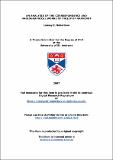Files in this item
An analysis of the correspondence and hagiographical works of Philip of Harvengt
Item metadata
| dc.contributor.advisor | Bartlett, Robert | |
| dc.contributor.author | Robertson, Lynsey E. | |
| dc.coverage.spatial | 261 | en |
| dc.date.accessioned | 2008-07-17T13:41:11Z | |
| dc.date.available | 2008-07-17T13:41:11Z | |
| dc.date.issued | 2008-06 | |
| dc.identifier.uri | https://hdl.handle.net/10023/526 | |
| dc.description.abstract | For every famous author of the twelfth-century renaissance, there are numerous lesser-known writers. Despite being overshadowed by more brilliant scholars or those closer to the centre of important events, their voices add depth to the study of the intellectual history of this period. A founding member of one of the earliest Premonstratensian houses; a highly-educated and prolific author, much in demand as a hagiographer; and a vigorous defender of the clerical order, Philip of Harvengt is one such writer, and a worthy subject for study. This thesis examines two bodies of Philip’s works – his letters and his hagiographical writings – analysing the predominant and recurrent concerns and ideals expressed in them, and the means by which they are expressed. The letters are carefully crafted works, examples of the literary labour which Philip writes is incumbent upon the cleric. The first part of this thesis approaches these letters in chapters on four themes: the role of the ecclesiastical prelate; the importance of learning; the relationship between religious orders; and Philip’s use of the motif of friendship. His hagiographical works, too, are examples of literary artistry, to move as well as to educate the audience. In the second part of the thesis, these will be discussed individually, with the first chapter analysing his vita of Oda, a nun attached to his own house, whom he portrays as a martyr. The succeeding chapters consider Philip’s rewritings of earlier vitae, and show how he managed his sources in order to produce vitae depicting their subjects according to his ideal model of sanctity. Philip’s letters express concerns shared by contemporaries, reflecting anxieties surrounding roles and ideal forms of living in a period immediately following the first fervour of religious renewal. His hagiographies articulate ideals of sanctity, clarifying these when they are not made sufficiently explicit in earlier works, for the better edification of an audience pursuing this vita perfecta. Both letters and hagiographies are designed to exhort and instruct the reader or listener: above all, Philip is a teacher. | en |
| dc.format.extent | 1348772 bytes | |
| dc.format.mimetype | application/pdf | |
| dc.language.iso | en | en |
| dc.publisher | University of St Andrews | |
| dc.rights | Creative Commons Attribution-NonCommercial-NoDerivs 3.0 Unported | |
| dc.rights.uri | http://creativecommons.org/licenses/by-nc-nd/3.0/ | |
| dc.subject | Philip of Harvengt | en |
| dc.subject | Correspondence | en |
| dc.subject | Hagiography | en |
| dc.subject | Learning | en |
| dc.subject | Martyrdom | en |
| dc.subject | Friendship | en |
| dc.subject | Regular canons | en |
| dc.subject.lcc | BX4705.P447R7 | |
| dc.subject.lcsh | Philip, of Harveng, Abbot of Bonne-Espeŕance, ca. 1100-1182 or 3--Correspondence | en |
| dc.subject.lcsh | Philip,of Harveng, Abbot of Bonne-Espeŕance, ca. 1100-1182 or 3--Criticism and interpretation | en |
| dc.subject.lcsh | Christian hagiography--History--To 1500 | en |
| dc.subject.lcsh | Premonstratensians--France | en |
| dc.title | An analysis of the correspondence and hagiographical works of Philip of Harvengt | en |
| dc.type | Thesis | en |
| dc.type.qualificationlevel | Doctoral | en |
| dc.type.qualificationname | PhD Doctor of Philosophy | en |
| dc.publisher.institution | The University of St Andrews | en |
This item appears in the following Collection(s)
Except where otherwise noted within the work, this item's licence for re-use is described as Creative Commons Attribution-NonCommercial-NoDerivs 3.0 Unported
Items in the St Andrews Research Repository are protected by copyright, with all rights reserved, unless otherwise indicated.


